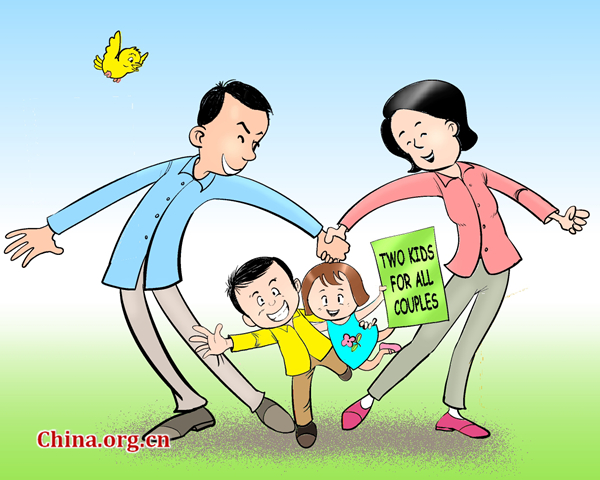China's demographic future
- By Dan Steinbock
 0 Comment(s)
0 Comment(s) Print
Print E-mail China.org.cn, November 3, 2015
E-mail China.org.cn, November 3, 2015
|
|
|
2 kids per couple [By Jiao Haiyang/China.org.cn] |
Like in most countries, the birth rate in China began to fall with industrialization and urbanization. In the Mao era, the crude birth rate almost halved from 37 to 20 per thousand, while infant mortality declined by over 75 percent. In the process, life expectancy almost doubled to 66 years in 1948-76, while population grew from 540 million to 940 million.
In the 1960s and 70s, birth planning was seen as a solution to China's economic problems and the slogan was "later, longer, fewer"; later marriages, longer spaces between children, and fewer of them.
While Mao's view was that population growth could empower the country, Deng Xiaoping favored reducing population growth. But even Deng advocated a goal, not a specific policy measure.
During a 1978 international conference, cybernetics expert Song Jian met Dutch theorists who had contributed to the then-famous Club of Rome report, Limits to Growth. Based on modeling, it forecast a catastrophe if world population would not be limited.
Based on these assumptions (which were discredited later), Song's own projections suggested that, without birth rate limitations, China's population would explode. The seemingly "scientific" ideas appealed to many in China, which had coped with years of ideological excess.
Not a one-size-fits-all policy
Ever since then, the policy has been widely criticized in the West. Yet, the new policy, which was initially designed as a one-generation measure, was never fully materialized in practice in China.
First of all, the policy allowed many exceptions and ethnic minorities were exempt. In accordance with China's affirmative action policies toward ethnic minorities, the latter have usually been allowed to have two children in urban areas and 3-4 in rural areas. In turn, ethnic Han people living in rural towns have been permitted to have two children.
Until the 2010s, only a third of China's population was subject to a strict one-child restriction. More than half of the Chinese were also allowed to have a second child if the first child was a girl.
Finally, the policy was not enforced from Beijing, but at the provincial level. As a result, enforcement varied and some provinces relaxed the restrictions. For instance, after Henan's policy relaxation, majority of the provinces and cities permitted two parents who came from one-child families to have two children.







Go to Forum >>0 Comment(s)